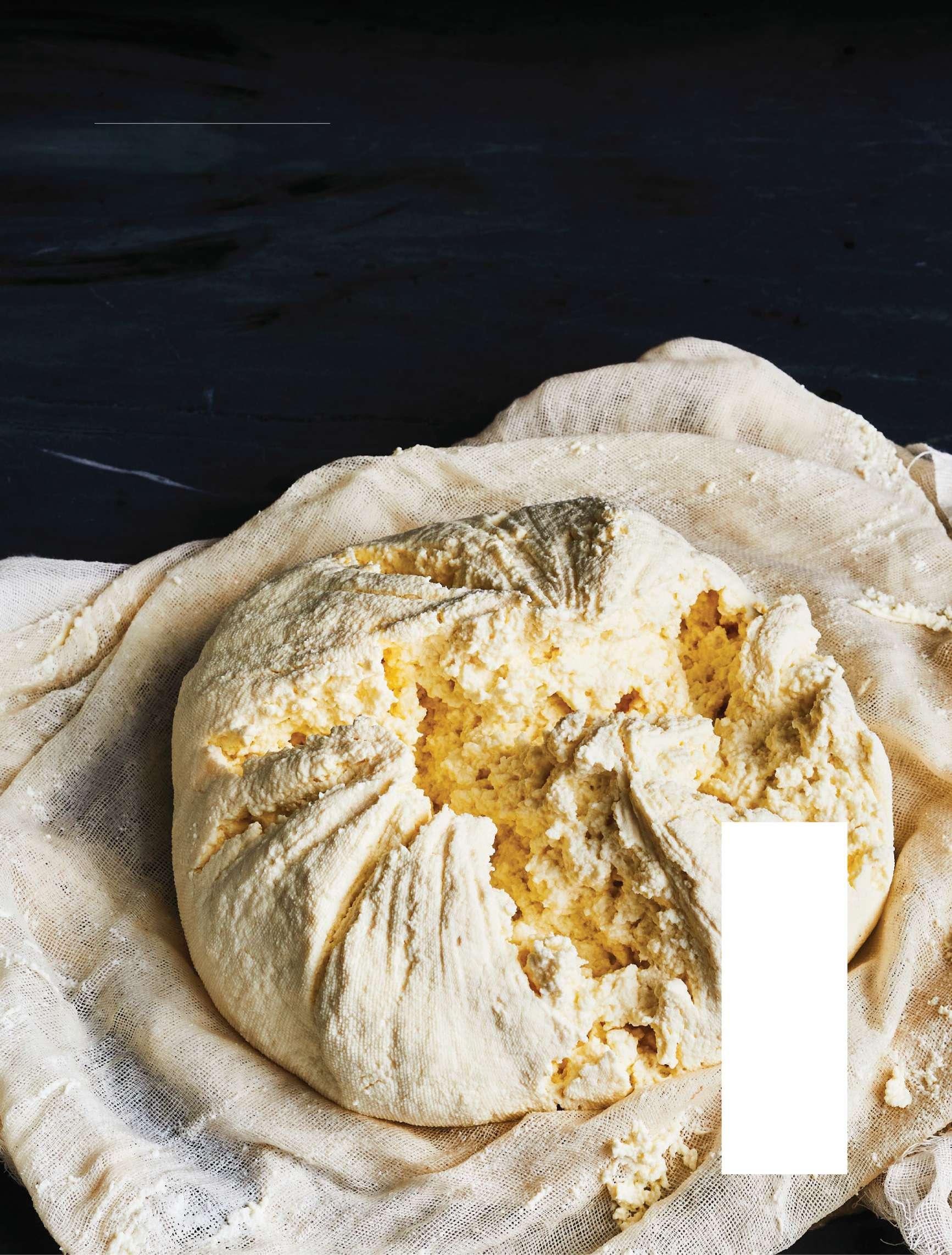
4 minute read
•• Homemade Fresh Ricotta
HANDBOOK
FOOD STYLING: MARGARET MONROE DICKEY; PROP STYLING: KATHLEEN COOK VARNER Just three ingredients and an easy technique produce fluffy, creamy fresh ricotta at home.
Advertisement
T H E T E C H N I Q U E
Lead the Whey Homemade ricotta takes spring cooking to the next level.
By Josh Miller and Paige Grandjean

HOMEMADE RICOTTA
“IT’S A MAGICAL THING to transform milk into cheese, and ricotta is a great first project,” says Betsy Devine, whose company, Salvatore BKLYN, keeps many of New York’s top restaurants stocked with fresh cheese. But who has time to make fresh cheese? As it turns out, you probably do. It takes just a few hours (most of it hands-off) and only three ingredients to make two pounds of fresh ricotta that’s fluffier and more flavorful than any supermarket version.
While many recipes for homemade ricotta call for acidic ingredients such as vinegar or lemon juice to separate the curds from the whey, this recipe leans on buttermilk. “Harsh acids denature the milk proteins, creating a tough and gritty cheese,” says Food & Wine’s Paige Grandjean, who swears by this recipe. “The lactic acid naturally found in buttermilk is less acidic, so the curds form slowly, producing a light and velvety texture.”
With just three ingredients, it’s essential to source the best you can find. “Homemade ricotta should taste like the freshest full-fat milk,” Devine says. “When you use great milk, you’re on your way to a great ricotta.” Grandjean agrees, adding it’s best to avoid ultra-pasteurized dairy, which has been processed at a high heat: It will prevent the cheese curds from forming properly. While the ricotta is the star , shining in recipes like Parmesan-Herb Gnudi (p. 36), Palak “Paneer” with Pressed Fresh Ricotta (p. 38), and Honey-Ricotta Mousse with Strawberries (p. 39), don’t discard the leftover whey. It is a great substitute for all or some of the liquid in yeasted bread recipes, where it adds a pleasant tang to the loaf. “It effortlessly mimics the complex flavor of sourdough bread,” Grandjean says. “Perfect for slathering with fluffy
1
HEAT MILK
Slowly heat milk, buttermilk, and kosher salt to 180°F, stirring occasionally to prevent bottom from scorching.
COOL CURD LAYER
Let stand, undisturbed, to let curds form and float to the surface, 2 to 3 hours. Curd will be surrounded by translucent yellow whey.
2
3
SET UP COLANDER
Set a colander over a large, deep bowl; line with a double layer of damp cheesecloth, leaving a 6-inch overhang.
DRAIN RICOTTA
Drain ricotta at room temperature; reserve whey for another use, if desired.
4
SCOOP CURDS
Using a fine wire-mesh strainer, gently scoop curds in large pieces, and transfer to prepared colander.
5 6
TWIST RICOTTA
Gather corners of cheesecloth, and lift ricotta. Gently twist to squeeze out remaining clear whey.
ACTIVE 45 MIN; TOTAL 3 HR 10 MIN MAKES ABOUT 21/4 LB. (ABOUT 5 CUPS)
This easy homemade ricotta cheese recipe only requires three ingredients—milk, buttermilk, and salt—and yields a light, fluffy ricotta that’s a delicious blank canvas for sweet or savory recipes, or you can enjoy it as a decadent toast topper. Source high-quality local dairy if possible for the richest flavor and best results.
1 gal. organic and/or grass-fed pasteurized whole milk 1 qt. organic and/or grass-fed buttermilk 1/2 tsp. kosher salt
1. Stir together milk, buttermilk, and salt in a large, heavy-bottomed stockpot. Cook over medium, stirring occasionally, until mixture reaches 180°F on an instantread thermometer, 30 to 40 minutes. Remove from heat; let stand, uncovered, at room temperature, until curds have formed and floated to the surface and are surrounded by clear whey, 2 to 3 hours. 2. Line a colander with a double layer of damp cheesecloth, leaving at least 6 inches of overhang on all sides. Set colander over a large bowl. Using a fine wiremesh strainer, gently scoop ricotta curds from stockpot, and place in colander. Keep curd pieces as large as possible to avoid overworking, which can toughen the ricotta. Let ricotta drain at room temperature 30 minutes for a creamy texture or up to 2 hours for a drier texture. Reserve whey in stockpot for another use. 3. Bring corners of cheesecloth together, and lift ricotta. Gently twist over colander to squeeze out any remaining clear whey from ricotta. Continue twisting until whey draining out becomes opaque and milky. Reserve drained whey for another use. Use ricotta immediately, or store in an airtight container in refrigerator up to 1
week. —PAIGE GRANDJEAN
MAKE AHEAD Ricotta can be made up to 1 week ahead and stored in an airtight container in refrigerator.
BETTER WITH BUTTERMILK
While pro cheesemakers rely on rennet, an enzyme used in commericial cheesemaking, most homemade ricotta recipes call for acidic lemon juice to help form the curds, which can turn tight and rubbery. Here, buttermilk gently transforms the milk into curds and whey —and yields more than double the ricotta as compared to recipes that use lemon juice.











